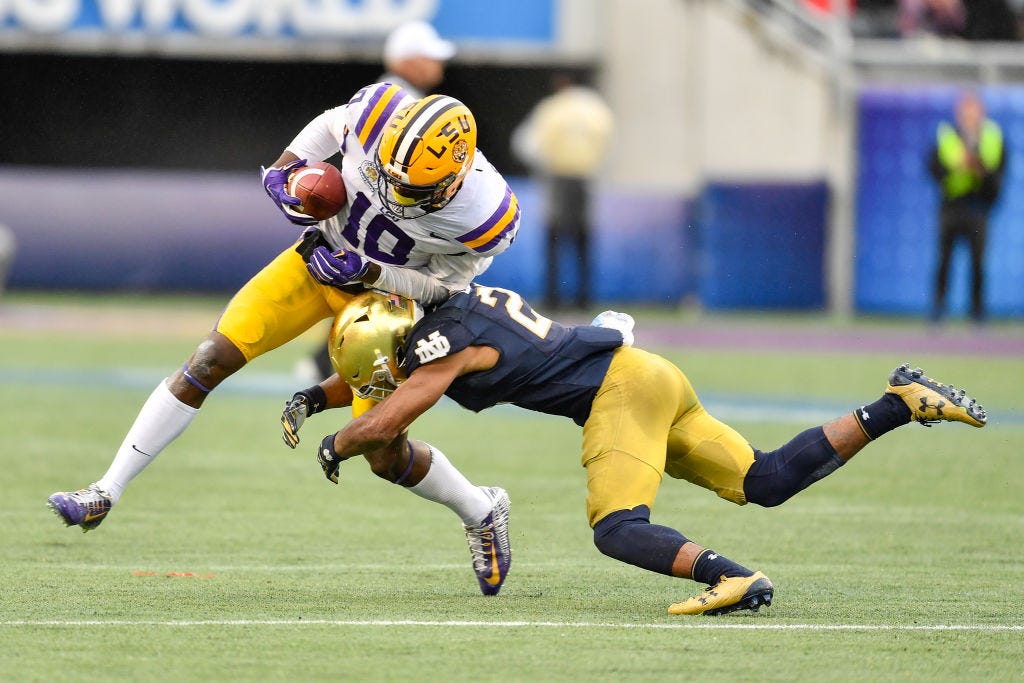How The Tricky History of Move Tight Ends Impact 2026 NFL Draft Prospects
Ben Glassmire examines why some of the best college tight ends don't succeed in the NFL despite being impressive pass catchers and which 2026 NFL draft prospects might fit that mold.
Kyle Pitts, Brock Bowers, Dalton Kincaid and Noah Fant were selected in the first round of the NFL draft in recent years in part due to their elite athleticism and potential upside as move tight ends.
You might hear “move” tight ends classified in numerous different ways depending on the coach and scheme; “U,” “Joker,” “F” or “flex” are all standard classifications.
These terms all refer to a particular mold of tight end that can be moved all over the formation to create mismatches against linebackers, safeties or cornerbacks. I’ll stick with calling them “move” tight ends for this article.
The cliché expression used to describe this archetype is that they are too big for a safety to deal with and too fast for a linebacker to cover, which rings true for many of these players. Traditionally, these players are labeled as poor blockers with elite physical gifts, making them a true mismatch.
If you think back to the first-round move tight ends listed above, you could easily argue that it's a failing model. Three out of the four — Fant, Pitts and Kincaid — have failed to live up to first-round expectations. That perfectly lays out the risk and reward evaluation teams must make when considering a move tight end.
The Modern Move Tight End
Before we fully discuss where the draft factors in, it’s essential to examine the current NFL landscape and how the league values move tight ends.
The current crop of move tight ends has stars like Travis Kelce, Sam LaPorta, Mark Andrews, Trey McBride and Bowers. There are also good, but limited players, like Jonnu Smith, Isaiah Likely and Evan Engram.
These players all win more as receivers than as blockers. However, many of these players have improved as blockers throughout their career despite having reputations as being pass-catchers first, an essential aspect to the success of this archetype.
This trend extends beyond the current generation of tight ends. One of the more memorable move tight ends, and a big reason I gained a love for the position, is former New Orleans Saints and Seattle Seahawks tight end Jimmy Graham.
Graham was one of my favorite players growing up, and I was probably the only Seahawks fan who proudly wore his jersey for so long (this was before I learned that having an offensive line is helpful; we still love you, Max Unger).
Graham was a freakish athlete who stood at 6 feet 6 inches and ran a 4.56 40-yard dash at his combine. Even today, that makes him a 96th percentile athlete for the position, according to Kent Lee Platt’s Relative Athletic Score.
Graham is known for his powerful goalpost dunk after scoring a touchdown, but ironically, he also scored in ways that look like layups. In the clip below, Graham’s first touchdown as a member of the Seahawks, he is aligned as the solo receiver toward the top of the screen against man coverage.
That is not an overly flashy touchdown, but it demonstrates my point. Despite his size, Graham moves fluidly and efficiently to get out of his break and create a window that quarterback Russell Wilson can easily get the ball into.
Graham was a unique player because of how impactful he was as a receiver despite being a relatively poor blocker. The easy knock on move tight ends is that they often struggle in that area, and while that can be true, the best will at least partially overcome that by being indispensable to their quarterbacks as a receiver.
Not all move tight ends are poor blockers like Graham, and those that can contribute in that area are even more valuable. Enter future Hall of Famer, Vernon Davis, who remains one of the best athletes to grace the position. Davis was a far better blocker than Graham, but he was truly great as a pass-catcher, where his elite athleticism and ball skills were paramount to his success.
The clip below is an excellent example of Davis' value to an offense. He is split out as a receiver in a 2x2 set. Davis runs a seam route that grants him one-on-one coverage with a linebacker with nowhere near the requisite speed to keep up with him, resulting in a massive gain.
An offense with a chameleon-like tight end who can stay on the field for all three downs has an enormous advantage. Davis not only contributed to the running game as a blocker but also stretched the field and forced the defense to make critical decisions on every play about who they were putting across from him.
By now, you are probably thinking, “Wow, he’s using Hall of Famers to make his point about the value of move tight ends in the modern NFL, what insightful analysis, next I bet he will tell us that Jeremiah Smith is an amazing wide receiver.”
Well, the joke would be on you because I’ve already done that.
However, it’s a fair critique, so I will enter Jonnu Smith into evidence. Smith enjoyed a career resurgence last season after joining forces with the Miami Dolphins and play caller Mike McDaniel. Smith is another high-level athlete and among the fastest tight ends in the league.
McDaniel understood the value that Smith could bring to the offense and inserted him as a true wild-card or joker-type player for a scheme built around the versatility of skill players like De’Von Achane, Jaylen Waddle and Tyreek Hill.
Not many tight ends are allowed to impact the game as McDaniel dreamt up for Smith. Even in this clip, a relatively mundane screen, shows why Smith was a perfect fit for McDaniel.
Smith is dynamic with the ball in his hands in a way that few tight ends are. This unique skill set reinforces the argument that a good move tight end forces defenses to think differently about how to address the offense they are facing.
Herein lies the value of move tight ends. They expand the menu of available playmakers and add one more dynamic piece to the passing game, similar to what an elite blocking tight end can do for a running game.
Why Don’t Move Tight Ends Succeed More?
The logic that move tight ends can open up an offense is easy to see in the college game. It makes even more sense for pass-happy offenses to employ a move tight end that creates easily exploitable mismatches, as the talent gap is often much wider in college than in the NFL.
Players like Devin Culp, Greg Dulcich, Grant Calcaterra and Harrison Bryant carved out impressive college careers as receiver-first tight ends that would help them get drafted in their respective classes.
What you probably noticed about that list is that none of those players had much success at the NFL level. That is where the catch with move tight ends starts to rear its ugly head.
This type of tight end is highly volatile, and career outcomes can vary wildly compared to other positions. When trying to diagnose why, one thing jumps out quickly: tight ends who primarily thrive as receivers have a much narrower path to sticking on a roster than those who can impact the game as blockers.
The flashy NFL tight ends who catch a ton of passes are their team's first option at the position. When you dig deeper into the TE2 and TE3s on depth charts, those that latch onto rosters must impact the game in more ways than just as a receiver.
There is little benefit for a team to keep a player around as the TE3 on the 53-man roster if they can’t contribute in multiple areas, similar to how many end-of-the-roster wide receivers must also contribute on special teams to be active on gameday and earn further opportunities on offense.
Players like Chris Manhertz, Josh Oliver and Drew Sample have had long careers due to their blocking, despite most fans not knowing them. While not always the most dynamic athletes or receivers, players like that will always find homes on teams looking for ways to bolster their running game and add depth at tight end.
NFL teams will always be looking for where they can gain an edge in roster composition, and if you can carry an extra wide receiver instead of a tight end primarily used as a receiver, why wouldn’t you?
The decision is not that simple, but it is a significant reason why fan-favorite college tight ends can struggle to be a mainstay on the team that drafted them. If the player cannot ascend the depth chart to the point where they are on the field enough to be a primary target for their team, they must contribute value in some other area.
One of my favorite case studies in this area is former LSU tight end Stephen Sullivan. As part of the record-breaking, national championship-winning 2019 Tigers team, Sullivan was the second tight end option behind Thaddeus Moss. When I scouted Sullivan for the 2020 draft, he looked like the better player and displayed freakish athleticism that I (wrongly) assumed would get him drafted early and onto the field often.
Sullivan would not live up to my expectations and got selected in the seventh round by the Seattle Seahawks (something I got far too excited about).
After struggling at tight end, the team tried flipping him to the defensive side of the ball before waiving him after the 2020 season. Sullivan has hung onto the Carolina Panthers roster in the past few years, but has not grown into the player I expected.
After whiffing on Sullivan, the takeaway was that when watching move tight ends, who tend to be far more athletic than their counterparts, it is easy to get swept away by raw talent.
As a result, it’s easy to forget or at least partially overlook that being a good football player right then and there matters more than the potential that you could project two or three years down the line. Simply put, a tight end drafted on Day 3 as a project might not make it to year three unless they can contribute in multiple areas.
Though I swung and missed on Sullivan, plenty of players of the same mold have had successful NFL careers. However, given the league's potential reemergent emphasis on the running game, the importance of having a tight end who can hold his own as a blocker will continue to rise.
Teams that emphasize 12 personnel (one back, two tight ends) need one, or preferably both, of those players to be effective in the running game. As a result, tight ends who are predominantly of the “move” variety will ideally either have positive reps as blockers that demonstrate what they could become with further experience and coaching or possess the frame and functional strength that allows coaches to develop those skills.
This is critical to remember when looking at the 2026 group of college players who fit this mold.
Though we are still far from the 2026 NFL Draft, college football has an exceptionally talented group of freakishly athletic and versatile tight ends. Though no Pitts or Bowers types can be locked in as a top pick, plenty of stars could blossom this season and in the right situation in the NFL.
Looking at the 2026 Draft’s Move Tight Ends
Keep reading with a 7-day free trial
Subscribe to Wide Left to keep reading this post and get 7 days of free access to the full post archives.






